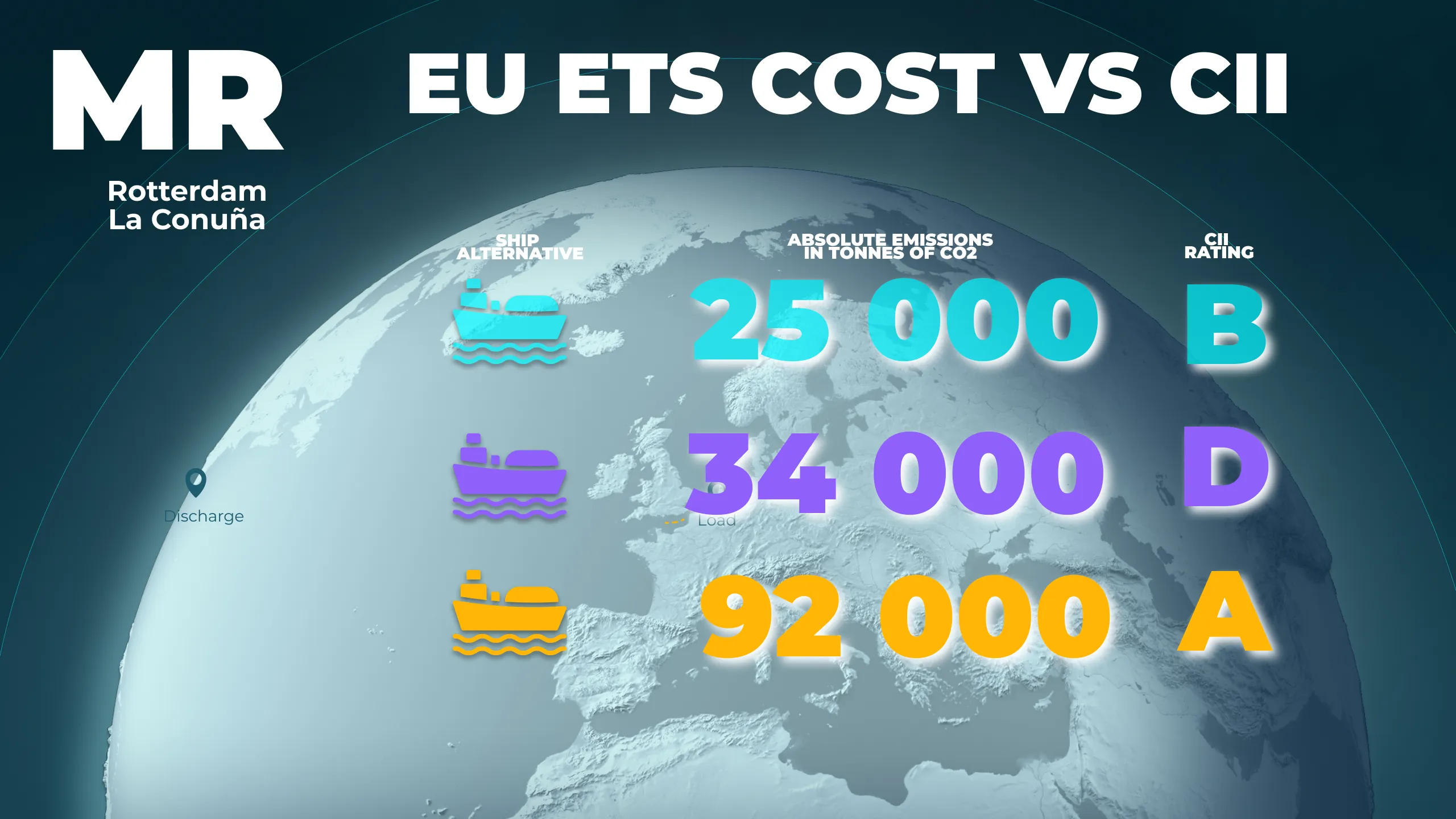Lorem ipsum dolor sit amet, consectetur adipiscing elit. Suspendisse varius enim in eros elementum tristique. Duis cursus, mi quis viverra ornare, eros dolor interdum nulla, ut commodo diam libero vitae erat. Aenean faucibus nibh et justo cursus id rutrum lorem imperdiet. Nunc ut sem vitae risus tristique posuere.
In an effort to demystify the CII for our customers, Siglar developed the voyage CII. When comparing the estimated CII of a specific voyage to the estimated emissions of the same voyage, some unintended consequences of the CII rating become apparent. Here we present common voyage examples highlighting how a CII approach to chartering can increase carbon emissions and cost.
The IMO’s Carbon Intensity Indicator (CII) rating introduces a global, easy-to-understand reference that brings my attention to operational carbon efficiency in shipping. This is a large and necessary step in the right direction.
However, the CII ratings have been met with criticism from many quarters. Our experience is that the CII does not provide professionals on the cargo side or the ship side with sufficient incentives to support carbon-efficient chartering decisions. Hence, the full potential of an operational measure to improve efficiency and reduce emissions is not realised.
The weakness of the current CII relates to the fact that the operational efficiency is based on Annual Energy Ratio (AER) calculations which disregard whether the ship is transporting cargo or not. Two consequences of leaving cargo out of the operational efficiency equation are:
In such cases, the CII rating can lead to sub-optimal chartering decisions and increased overall emissions. The CII can therefore work against the IMO’s intended purpose which is to reduce shipping emissions.
The best way to understand the consequences of da chartering decisions is to zoom in on single voyages. So, to help our customers understand how their chartering decisions impacted the CII, we developed the Voyage CII. When comparing the CII rating of a voyage to its absolute emissions it is easy to find examples where CII rating and absolute emissions do not coincide.

Have a closer look at this example.

Have a closer look at this example.

Have a closer look at this example.
From the charterers’ point of view, understanding CII variations and how the cargo in question would contribute to each ship’s annual CII is useful in charter party negotiations. However, if the aim is to reduce emissions and the related carbon cost, absolute numbers, measured in tonnes of CO2, are the appropriate indicators. Measuring and estimating absolute emissions allows charterers to understand the carbon consequence of their shipping decisions and to make ca chartering decisions.
From a charterer’s perspective, the best moment to avoid unnecessary shipping emissions is when planning the voyage. Measuring in absolute emissions allows the charterer to estimate the carbon consequence of pre-fixture shipping decisions, like how the ballast leg and cargo destination impact emissions. Understanding the emissions impact and the related carbon cost of the ballast leg and the cargo destination might trigger the use of flexibility in the chartering program. Using this flexibility leaves opportunities to slash emissions at low cost and at large scale.

The IMO’s Carbon Intensity Indicator (CII) rating introduces a global, easy-to-understand reference that brings my attention to operational carbon efficiency in shipping. This is a large and necessary step in the right direction.
However, the CII ratings have been met with criticism from many quarters. Our experience is that the CII does not provide professionals on the cargo side or the ship side with sufficient incentives to support carbon-efficient chartering decisions. Hence, the full potential of an operational measure to improve efficiency and reduce emissions is not realised.
The weakness of the current CII relates to the fact that the operational efficiency is based on Annual Energy Ratio (AER) calculations which disregard whether the ship is transporting cargo or not. Two consequences of leaving cargo out of the operational efficiency equation are:
In such cases, the CII rating can lead to sub-optimal chartering decisions and increased overall emissions. The CII can therefore work against the IMO’s intended purpose which is to reduce shipping emissions.
The best way to understand the consequences of da chartering decisions is to zoom in on single voyages. So, to help our customers understand how their chartering decisions impacted the CII, we developed the Voyage CII. When comparing the CII rating of a voyage to its absolute emissions it is easy to find examples where CII rating and absolute emissions do not coincide.

Have a closer look at this example.

Have a closer look at this example.

Have a closer look at this example.
From the charterers’ point of view, understanding CII variations and how the cargo in question would contribute to each ship’s annual CII is useful in charter party negotiations. However, if the aim is to reduce emissions and the related carbon cost, absolute numbers, measured in tonnes of CO2, are the appropriate indicators. Measuring and estimating absolute emissions allows charterers to understand the carbon consequence of their shipping decisions and to make ca chartering decisions.
From a charterer’s perspective, the best moment to avoid unnecessary shipping emissions is when planning the voyage. Measuring in absolute emissions allows the charterer to estimate the carbon consequence of pre-fixture shipping decisions, like how the ballast leg and cargo destination impact emissions. Understanding the emissions impact and the related carbon cost of the ballast leg and the cargo destination might trigger the use of flexibility in the chartering program. Using this flexibility leaves opportunities to slash emissions at low cost and at large scale.
